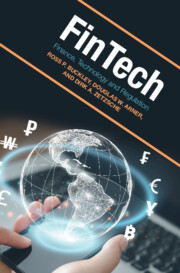Book contents
- FinTech
- FinTech
- Copyright page
- Contents
- Figures
- Acknowledgements
- Abbreviations and Technical Terms
- 1 Introduction
- Part I Digital Transformation of Finance and Regulation
- 2 Evolution of FinTech
- 3 Smart Regulation
- 4 RegTech and the Reconceptualisation of Financial Regulation
- 5 COVID-19, Digital Finance, and Existential Sustainability Crises
- 6 Drivers of Change
- Part II Addressing the Challenges of Innovation in Finance
- Part III Building Better Financial Systems
- Part IV From FinTech to TechFin to BigTech to FinTech 4.0
- Part V Conclusion
- Index
2 - Evolution of FinTech
from Part I - Digital Transformation of Finance and Regulation
Published online by Cambridge University Press: 09 November 2023
- FinTech
- FinTech
- Copyright page
- Contents
- Figures
- Acknowledgements
- Abbreviations and Technical Terms
- 1 Introduction
- Part I Digital Transformation of Finance and Regulation
- 2 Evolution of FinTech
- 3 Smart Regulation
- 4 RegTech and the Reconceptualisation of Financial Regulation
- 5 COVID-19, Digital Finance, and Existential Sustainability Crises
- 6 Drivers of Change
- Part II Addressing the Challenges of Innovation in Finance
- Part III Building Better Financial Systems
- Part IV From FinTech to TechFin to BigTech to FinTech 4.0
- Part V Conclusion
- Index
Summary
This chapter analyses the evolution of finance and technology. In the modern era, we mark this in four major periods. The first focused on electrification and lasted for a century until the mid-to-late 1960s. It was dominated by analogue processes and traditional banks. The second period of digitisation was marked by digitisation, including across securities markets (NASDAQ), payments (ATMs, SWIFT), mass computerisation (financial calculators, PCs), communications (Internet, mobile), and lasted 40 years. From around 2007–2008 onwards, a new trend emerged as a result of the application of a range of new technologies to finance, combined with the impact of the 2008 GFC on finance and regulation. These three driving forces– the 2008 Crisis, the application of a range of new and transformative technologies to finance, and a massive increase in regulation globally in response to 2008 and a range of financial scandals– underpinned the emergence of FinTech, short for ‘financial technology’. This third period lasted just over 10 years and saw the rise of data, and its algorithmic analysis in a process called datafication which has transformed finance. The most recent era, driven by the COVID pandemic, commenced in 2020 and is characterised by the emergence of scale, in the form of large digital platforms.
- Type
- Chapter
- Information
- FinTechFinance, Technology and Regulation, pp. 11 - 26Publisher: Cambridge University PressPrint publication year: 2023



